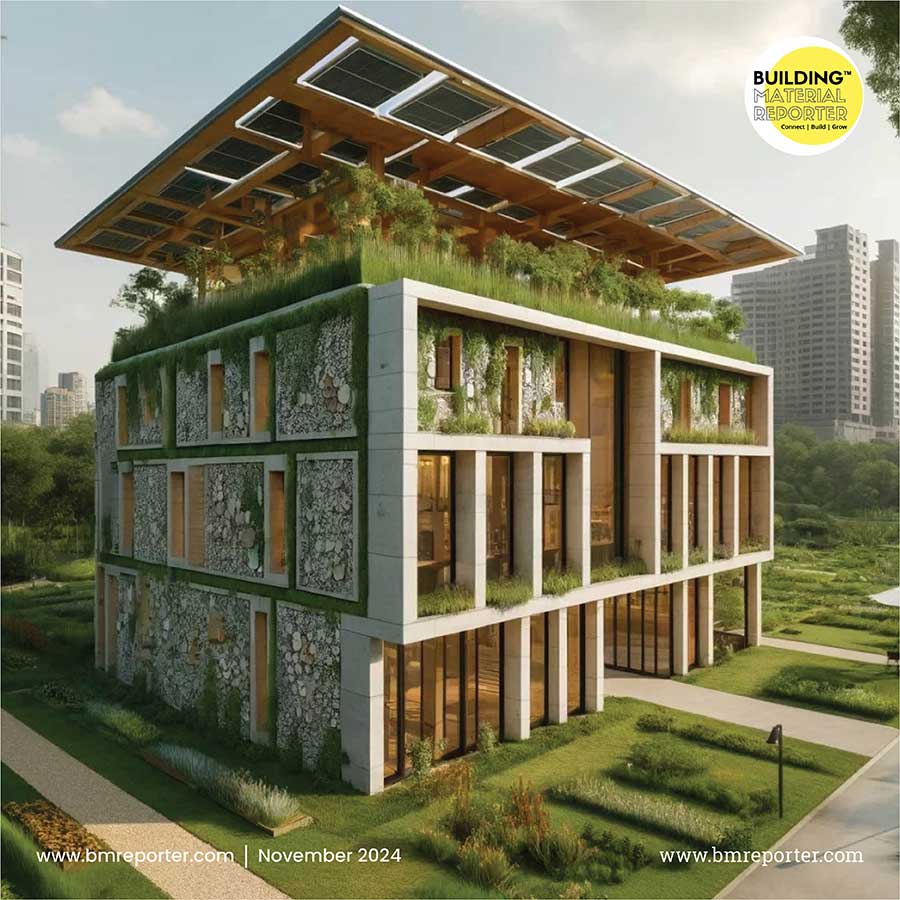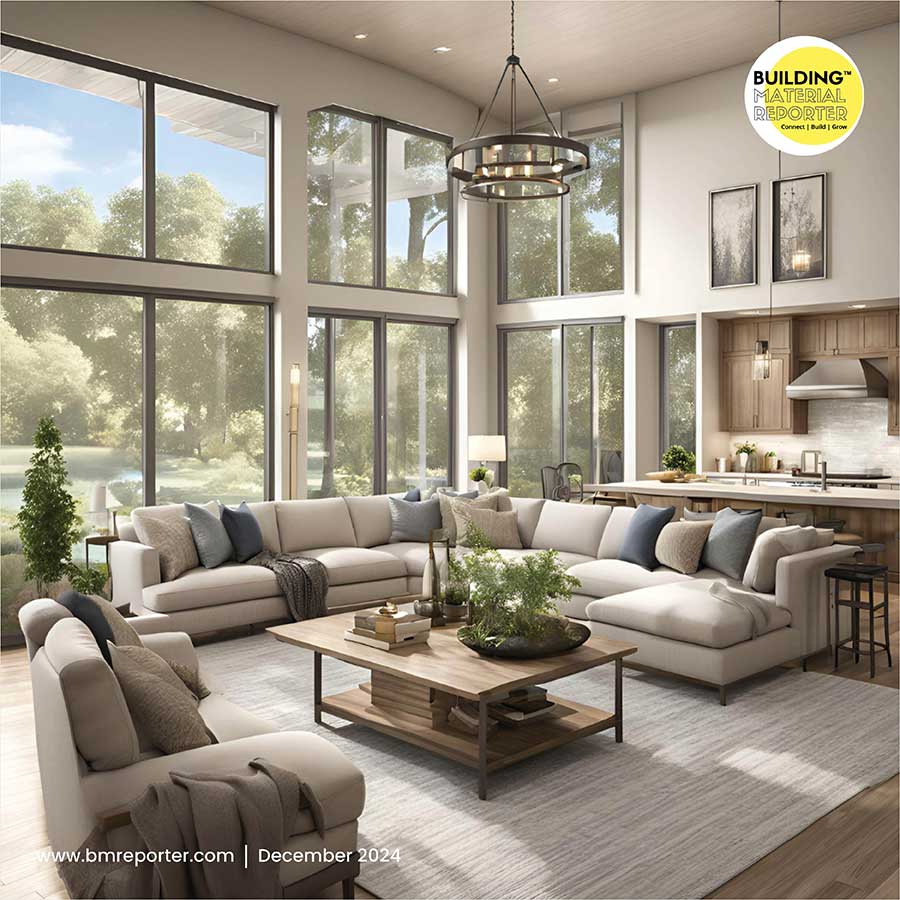Discovering The Beauty Of Drywalls
- December 26, 2024
- By: Syed Md. Ehteshamul Hasan
- PRODUCTS AND MATERIALS
Modern architectural design revolves around harmonising aesthetics with functionality. As the celebrated German industrial designer Dieter Rams aptly stated, "Good design is not about making things look beautiful; it's about making things work beautifully." Today’s designs blend innovative materials with thematic concepts to create spaces that are not only visually appealing but also practical and efficient.
With advancements in technology, new materials and products are reshaping design by fostering openness, connectivity, and sustainability. Whether embracing industrial-inspired elements or eco-conscious solutions, these innovations are blurring traditional boundaries and redefining the essence of design.
In the realm of contemporary design, each day brings fresh discoveries in materials and products, sparking excitement among designers and clients alike. In this Building Material Reporter feature, we explore one such transformative innovation: Drywalls. Let’s dive in to uncover their potential and impact.

What’s a Drywall?
Drywall is a modern, lightweight walling solution composed of a galvanised steel framework clad with gypsum plasterboards on both sides, fastened with self-drilling screws. The seams are finished with tape and a gypsum-based jointing compound for a seamless appearance. While widely recognised for interior applications, advancements in technology have made these drywalls equally suitable for exterior use, offering durability and versatility for complete architectural solutions. From crafting extraordinary interior environments to providing durable and efficient exterior applications, drywalls offer versatility, reduce structural loads, and minimise labour requirements, making them an ideal choice for modern construction practices.
Essentially, drywall comprises gypsum—a naturally occurring mineral—encased between two sturdy sheets of paper. This material serves as a sustainable and flexible alternative to traditional construction methods, offering unmatched adaptability for diverse residential and commercial applications. Whether used to create simple partitions or intricate architectural features, drywall delivers efficiency and versatility with reduced labour and time requirements.

Conventional Methods vs. Drywalls: The Better Choice
Drywalls have revolutionised modern construction, becoming a preferred choice for architects and designers due to their efficiency and adaptability. Unlike conventional construction methods, drywalls allow for seamless partitions and divisions without adding unnecessary bulk to a space—a true asset in contemporary design. Let’s explore why drywalls are setting new benchmarks in construction:
1. Flexibility: Drywalls are highly versatile and can be installed effortlessly in tight spaces or around curves, accommodating a variety of design needs. In comparison, conventional methods are less adaptable and require skilled labour for proper execution, while Gyproc’s Drywalls, with their innovative design, excel in creating unique and efficient spatial solutions.
2. Work Hygiene: One major drawback of traditional methods is the dust and debris generated during construction, leading to longer clean-up times and disruption. Drywalls, however, minimise dust during installation, making the process cleaner and more convenient. Post-installation clean-up is also faster, simple and hassle-free.
3. Sustainability: Drywalls are a more environmentally friendly option compared to bricks or blocks. The production of bricks/blocks demands high energy input and emits considerable carbon dioxide, contributing to environmental degradation. Drywalls, made from gypsum—a naturally occurring and easily processed mineral—have a significantly lower environmental footprint. Additionally, drywalls are recyclable, whereas bricks or blocks, being porous and less durable over time, pose challenges in recycling and reusability.
4. Hygiene & Maintenance: Traditional construction methods often result in structures that trap moisture and dirt, leading to hygiene concerns over time. Gypsum drywalls provide a smooth and easy-to-clean surface, ensuring practicality for maintaining cleanliness in modern spaces. Their design also supports durability and long-lasting hygiene standards, making them an excellent choice for both residential and commercial applications.
5. Faster Construction Leads To Cost-Effectiveness: Drywalls are not only lighter on structural loads but also on the budget. Their lightweight design and ease of installation significantly speed up the construction process compared to conventional methods. This results in reduced labour costs and shorter construction timelines, offering better value over the traditional or conventional construction approaches. Furthermore, the quick and straightforward installation of drywalls enhances cost efficiency while maintaining exceptional quality and performance.
6. Moisture Resistance: Drywalls, with their superior moisture-resistant properties, are ideal for damp-prone areas such as bathrooms, kitchens, and basements. Unlike conventional walls that often require additional waterproofing or treatments, moisture-resistant Gyproc’s gypsum boards are pre-engineered to withstand humidity. This not only enhances durability but also reduces construction time and costs. By combining speed, performance, and reliability, drywalls stand out as an efficient solution for modern building needs.
In today’s fast-evolving construction landscape, drywalls—especially Gyproc’s Drywalls—stand out as the ultimate solution for modern living. From flexibility and sustainability to enhanced hygiene and affordability, they deliver on all fronts and go beyond expectations to offer a multitude of additional benefits. For builders, designers, and homeowners alike, Gyproc’s Drywalls are truly the smart choice for contemporary spaces.

Overview of Other Benefits: Drywalls are a game-changer in modern construction, offering faster installation, reduced labour, and significant time savings compared to conventional methods of construction. They excel in providing excellent sound insulation, superior fire resistance, and structural cost efficiency. These advantages make drywalls a reliable choice for enhancing the quality of residential and commercial spaces. Here’s how drywalls elevate the overall living experience:
- Improve indoor comfort with fire, acoustic, and thermal insulation
- Enable flexible partitioning to create customised and comfortable spaces
- Deliver smooth wall surfaces that enhance the aesthetic appeal of interiors
When it comes to achieving these benefits and more, Gyproc’s Drywalls stand out as a preferred choice. Designed with innovation and performance in mind, they offer all these advantages along with a multitude of additional features, ensuring unparalleled quality and satisfaction in every space they transform.

Drywalls: A Superior Solution for Enhanced Fire Resistance
Gypsum board-based drywalls, along with beam and column encasements, offer a highly effective solution to significantly reduce fire-related damages. When it comes to compartmentalization, fire-rated drywalls are the ideal choice.
Gypsum's core is the key to its excellent fire resistance. Gypsum is naturally non-combustible because its crystals contain water, which makes up nearly 21% of its weight. This chemically bound water plays a crucial role in making gypsum an effective fire-resistant material. When exposed to high temperatures, the water within gypsum evaporates slowly as steam, thereby significantly slowing down the transmission of heat through the drywall.
Unlike conventional brick or masonry walls, which can crack under extreme heat and lose their structural integrity, gypsum drywalls maintain their form and functionality, providing extended protection during a fire. Additionally, while traditional walls often require thicker constructions to achieve similar fire ratings, gypsum drywalls deliver the same or better fire resistance with a thinner profile, saving space without compromising safety.
According to standards such as BS 476: Part 7: 1997 for surface spread of flame, gypsum plasterboards are classified as Class 1—the highest level of resistance to flame spread. This classification means that gypsum-based drywall solutions can provide fire protection for up to 4 hours, ensuring superior fire safety in both residential and commercial spaces.
Discovering Different Perspectives on Drywalls
In the ever-evolving field of design, diverse opinions from experienced architects and designers enrich the discourse and offer valuable insights. When it comes to drywalls, these nuanced perspectives reveal the growing acceptance and versatility of this innovative material in modern construction.
Ar. Sushant Madan, Co-Founder & Principal Designer at Designery, emphasised the transformative impact of technology and changing consumer mindsets on the popularity of drywalls. He remarked, “With technology advancements and myths around drywalls addressed, they are now favoured for their lightweight and customisable nature. Their energy efficiency makes them ideal, especially as awareness of climate change grows.”
From both aesthetic and functional standpoints, drywalls offer distinct advantages. Ar. Katsushi Goto, Director at Squareworks LLP, added, “Aesthetically, drywalls are neutral, while functionally, they allow faster construction than conventional methods. However, user expectations for solid walls differ, making them incomparable to brick walls.”
The commitment to sustainability and ethical design is another significant dimension of drywall usage. Elham Mirza, Principal Interior Designer at The Wall By Elham, highlighted, “Drywalls meet sustainability and health safety standards, ensuring eco-friendliness and ethical material sourcing. They align with designers’ growing commitment to creating environmentally responsible and occupant-safe spaces.”
These perspectives illustrate how drywalls are redefining modern construction. Their lightweight nature, sustainability, and adaptability make them a valuable asset in contemporary design while continuing to spark dialogue among industry professionals.
Future Prospects: As markets evolve, innovation advances, and ideas shift, drywalls continue to adapt and transform. Their flexibility in contemporary design and construction has significantly influenced modern spaces. With growing emphasis on sustainability and smarter applications, the future of drywalls looks promising and poised for further evolution.
Ar. Shreshth Guptaa, Founder & Principal Designer at Acroterion Labs, aptly remarked, “Keeping pace with the evolving market, drywalls strike a perfect balance between functionality and aesthetics, solidifying their position as a preferred choice for builders, architects, and designers.”
This synergy of innovation and adaptability ensures that drywalls remain at the forefront of modern construction, shaping the future of sustainable and versatile design.

Conclusion
Drywalls have actually revolutionised today’s construction with their unmatched versatility, sustainability, and performance. The modern innovative drywall solutions not only enhance aesthetics and functionality but also ensure superior fire resistance, moisture protection, and cost efficiency. Whether for residential or commercial applications, these drywalls are setting new benchmarks in contemporary architecture, delivering smart, reliable, and future-ready building solutions. The time is right to embrace the power of drywalls—mainly Gyproc’s Drywalls—to transform your spaces into modern masterpieces!
Stay Connected with Building Material Reporter
At Building Material Reporter, we are committed to bringing you the latest and most impactful updates from the world of construction and design. Stay tuned for more insights and ideas on cutting-edge construction technology, green buildings, home decor, interior design, innovative materials, new projects, and architectural advancements. Your go-to source for inspiration and knowledge in the industry—because we believe in serving the best.








